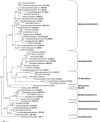Diversity of microorganisms within rock varnish in the Whipple Mountains, California
- PMID: 16461735
- PMCID: PMC1392883
- DOI: 10.1128/AEM.72.2.1708-1715.2006
Diversity of microorganisms within rock varnish in the Whipple Mountains, California
Abstract
Rock varnish from Arizona's Whipple Mountains harbors a microbial community containing about 10(8) microorganisms g(-1) of varnish. Analyses of varnish phospholipid fatty acids and rRNA gene libraries reveal a community comprised of mostly Proteobacteria but also including Actinobacteria, eukaryota, and a few members of the Archaea. Rock varnish represents a significant niche for microbial colonization.
Figures


References
-
- Adams, J. B., F. Palmer, and J. T. Staley. 1992. Rock weathering in deserts: mobilization and concentration of ferric iron by microorganisms. Geomicrobiol. J. 10:99-115.
-
- Allen, C. C., F. Westall, and R. T. Schelble. 2001. Importance of a martian hematite site for astrobiology. Astrobiology 1:111-123. - PubMed
-
- Altschul, S. F., W. Gish, W. Miller, E. W. Myers, and D. J. Lipman. 1990. Basic local alignment search tool. J. Mol. Biol. 215:403-410. - PubMed
-
- Anderson, R. C. 1995. Spectral mapping of quaternary geomorphic surfaces in the Whipple and Piute Mountains of southeastern California using visible and near infrared datasets. Ph.D. dissertation. University of Pittsburgh, Pittsburgh, Pa.
Publication types
MeSH terms
Substances
Associated data
- Actions
- Actions
- Actions
- Actions
- Actions
- Actions
- Actions
- Actions
- Actions
- Actions
- Actions
- Actions
- Actions
- Actions
- Actions
- Actions
- Actions
- Actions
- Actions
- Actions
- Actions
- Actions
- Actions
- Actions
- Actions
- Actions
- Actions
- Actions
- Actions
LinkOut - more resources
Full Text Sources
Molecular Biology Databases

